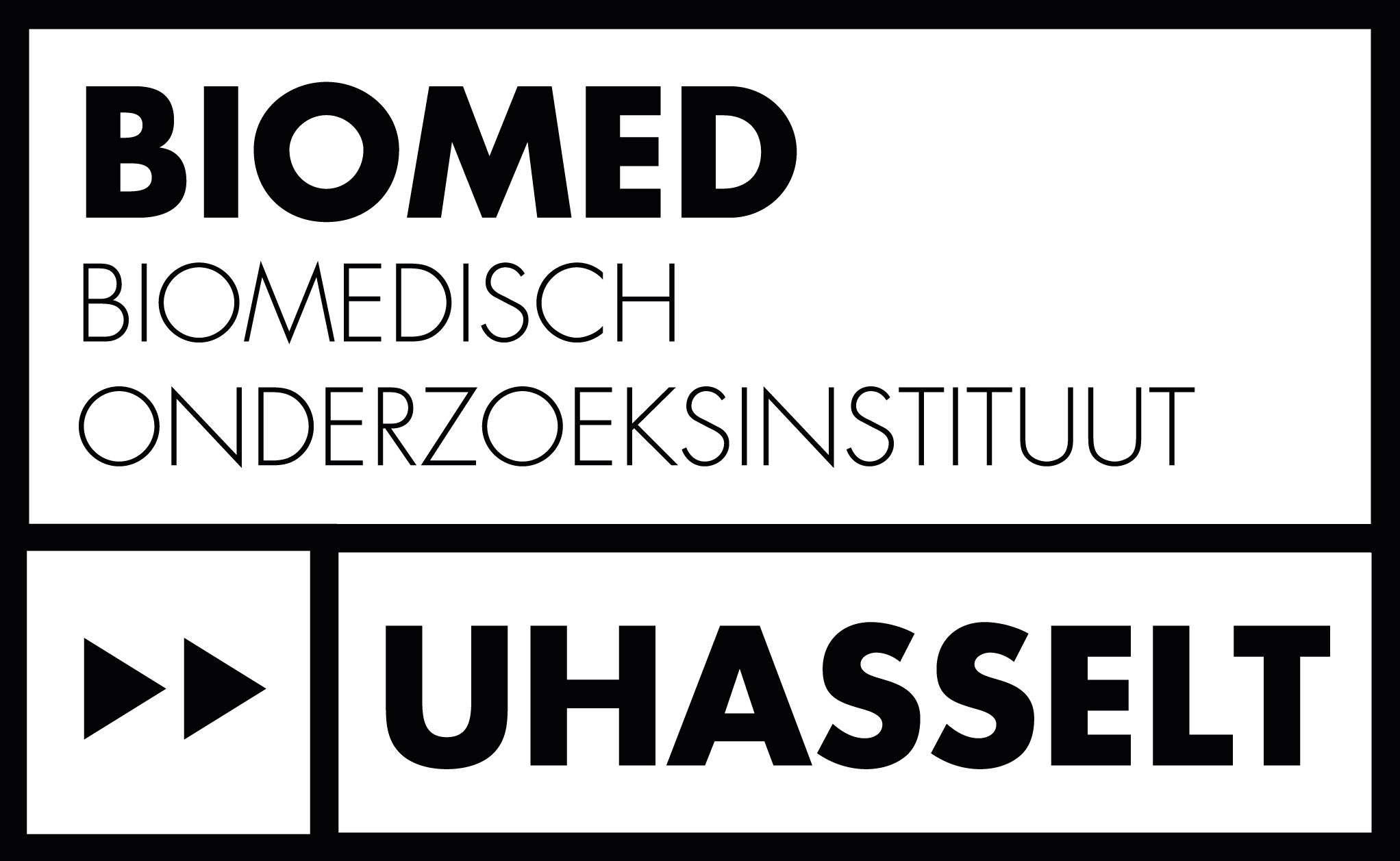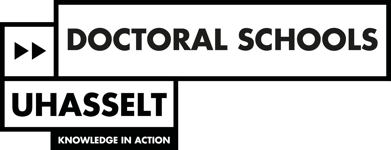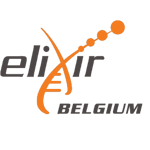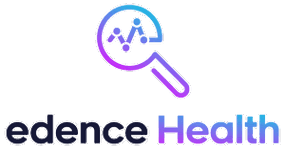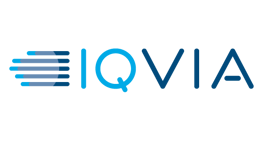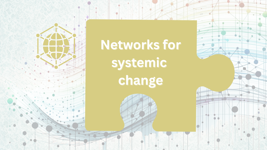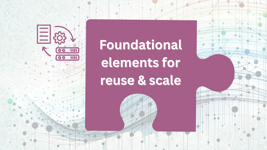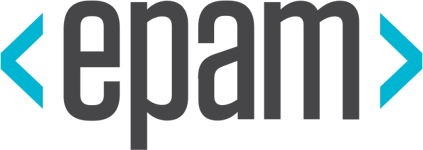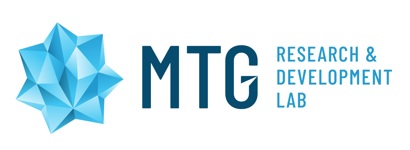2025 OHDSI Europe Symposium
This event has already taken place.
OHDSI Europe Symposium 2025 - Report is out now!
The report of the 6th OHDSI Europe Symposium – Join the Network: Advancing Real-World Evidence in Europe is now available for download.
Held on July 7, 2025, at the historic Old Prison building of Hasselt University, this milestone edition brought together 365 participants from academia, industry, healthcare, and policy to advance real-world evidence in Europe.
The report captures the highlights of the event, including tutorials, workshops, over 100 poster presentations, and strategic discussions on the future of OHDSI and the European Health Data Space. It showcases how the European OHDSI network continues to grow as a trusted, collaborative research community driving impact for patients across Europe.
🎥 OHDSI Europe Symposium 2025 Recordings Now Available
The recordings of the OHDSI Europe Symposium 2025 are now available on the OHDSI YouTube channel.
Relive the insights, innovations, and community highlights from across the European OHDSI network by exploring the full session videos below.
Session 1 – Welcome to the European OHDSI Journey
This opening session marked the start of the OHDSI Europe Symposium 2025 with a spotlight on the growth and direction of the European OHDSI community. Liesbet Peeters and Peter Rijnbeek welcomed participants and set the tone for a day of collaboration and innovation. Patrick Ryan followed with a keynote exploring OHDSI’s journey so far and the opportunities ahead.
Renske Los introduced the impact of the OMOP Common Data Model across national contexts, with featured contributions from:
-
Alex Knight (UK) on study-a-thons and collaboration with the NHS
-
Lucia Sacchi (Italy) on the Data Protection Impact Assessment template
-
Eric Fey (Finland) on FinOMOP and Swarm Learning
Together, the session celebrated progress and strengthened the shared vision for generating reliable, scalable evidence through European collaboration.
👉 Watch Session 1
Session 2 – Collaborator Showcase: Rapid Fire Presentations
This high-energy session spotlighted the diversity and creativity of OHDSI research across Europe through a series of rapid-fire presentations. Hosted by Annelies Verbiest (University Hospital Antwerp), the showcase featured eight concise talks highlighting novel applications of real-world data, AI, and OMOP-CDM innovations:
-
Nicholas Hunt (Erasmus Medical Centre, The Netherlands)
-
Elin Rowlands (University of Oxford, UK)
-
Angela Leis (Hospital del Mar Research Institute, Spain)
-
Kerli Mooses (University of Tartu, Estonia)
-
Fleur Vereijken (Erasmus Medical Centre, The Netherlands)
-
Karlo Pintarić (Croatian Institute of Public Health, Croatia)
-
Sariga Kakkamani (Hasselt University, Belgium)
-
Pedro Campos (VaultHaus, Portugal)
The session underscored the innovation, agility, and collaborative spirit that define the OHDSI community’s cutting-edge contributions across Europe.
👉 Watch Session 2
Session 3 – Bridging Policy and Practice: OHDSI’s Role in Implementing the European Health Data Space
The final session of the OHDSI Europe Symposium 2025 brought leading experts together for a dynamic panel debate on the role of OHDSI in supporting the European Health Data Space. Moderated by Liesbet Peeters (Hasselt University) and Dipak Kalra (European Institute for Innovation through Health Data), the discussion highlighted how real-world data, open science, and collaborative infrastructure can drive evidence-based health policy across Europe.
Panelists included:
-
Patrick Ryan (Johnson & Johnson)
-
Denise Umuhire (European Medicines Agency)
-
Enrique Bernal-Delgado (Instituto Aragonés de Ciencias de la Salud, Spain)
-
Talita Duarte-Salles (IDIAPJGol / Erasmus MC)
-
Nick Marly (Advisor to the Belgian Minister of Public Health & Social Affairs)
Closing Ceremony
To wrap up a day of deep insights and connection, Liesbet Peeters delivered heartfelt closing remarks—celebrating not just the scientific progress, but also the spirit of the OHDSI community. The ceremony ended in true OHDSI Europe fashion: with dancing, unicorns, butterflies, and frogs—reminding us that serious science is best fueled by joy, imagination, and a bit of magic.
Thank you for an incredible OHDSI Europe Symposium 2025!
What an unforgettable gathering! A heartfelt thank you to all our speakers, sponsors, working group leaders, collaborator showcase contributors and participants for making the OHDSI Europe Symposium 2025 such a remarkable event.
We’re excited to share the official group photo below – a snapshot of a vibrant and growing community, brought together by a shared mission to improve health through data.
📸
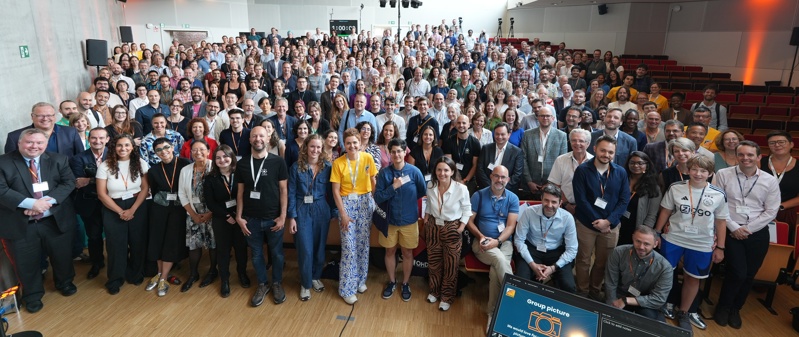
We’ll be sharing more pictures, session recordings, and – after the summer – a full event report, so stay tuned!
It was truly amazing to connect with so many of you and see the energy, insights, and collaboration that drive our work forward. Thank you for being part of this journey.
See you next year in Rotterdam, April 18–20, 2026!
#OHDSIEurope2025 #JoinTheNetwork #DataSavesLives #ThankYou
Plan ahead: Final Program Booklet available now!
The Program Booklet can be consulted via this link.

Explore the Venue & Presentations
Symposium Venue Floorplan
Symposium Venue Floorplan

Collaborator Showcase - Software Demonstrations
Collaborator Showcase - Software Demonstrations
OHDSI-in-a-File: A Self-Contained Browser-Based Notebook for Research
Pedro Campos (VaultHaus), Luis Martinho (VaultHaus), Pedro Santos (VaultHaus), Tiago Silva (VaultHaus), Cláudia Amorim Vaz (ULS Tâmega e Sousa)
OHDSI-in-a-File is a novel platform enabling comprehensive OHDSI analytical workflows to run entirely within a standard web browser, packaged as a portable single HTML file. It leverages WebR (R via WebAssembly) and an in-memory DuckDB instance to execute analyses client-side, eliminating server dependencies and installation requirements. This demonstration will showcase its interactive notebook interface performing cohort studies, drug utilization, and outcome analyses on OMOP CDM data loaded from user-provided CSVs (e.g., GiBleed) or generated mock data. We will highlight its ease of use and reproducibility, rapid prototyping capabilities, and potential for democratizing OHDSI research in education, training, and resource-constrained settings.
(check poster here)
OmopSparkConnector – native Databricks support for the OMOP CDM
Edward Burn, Cecilia Campanile (University of Oxford), Timothy Howcroft, Vishnu Chandrabalan (Lancashire Teaching Hospitals), Marti Catala Sabate
OmopSparkConnector is a new R package that enables native support for the OMOP CDM within Databricks, a cloud platform increasingly adopted for large-scale data analytics. Built on the sparklyr and omopgenerics foundations, the connector empowers users to perform OHDSI network studies while taking full advantage of Spark-native capabilities—such as in-memory dataframes, parallel processing, and machine learning workflows. The demo will show how users can seamlessly integrate OMOP CDM data with standard OHDSI tools like CohortConstructor, IncidencePrevalence, and DrugUtilisation, while also running Spark-specific operations like summaries and clustering. This solution enhances both flexibility and performance, especially for institutions managing massive datasets in Databricks.
Federated Platform for Clinical Data Mediation: Enhancing Interoperability with OMOP and NLP
Mónica Arrúe, María Quijada, Paula Chocrón, Josep Cordón, Gabriel de Maeztu (IOMED Medical Solutions, Universitat de Barcelona)
IOMED’s Data Space Platform (DSP) is a federated infrastructure designed to bridge the gap between hospitals and researchers by streamlining data mediation, approval, and governance workflows. It combines OMOP CDM standardization, natural language processing (NLP), and automated terminology mapping to transform unstructured clinical data into high-quality, research-ready datasets. Hospitals retain full control over data access and approvals, while research sponsors benefit from faster project initiation and transparent compliance tracking. The demo will showcase how DSP enables real-time project monitoring, integrated ethics and contract management, and secure, anonymized data sharing—all within a single interface—making it a cornerstone technology for scalable, GDPR-compliant research in the European Health Data Space.
(check poster here)
Searching the HMA-EMA Real-World Data Catalogues: Insights into Common Data Models
Elpida Kontsioti, Stefania Simou, Katerina-Christina Deli, Paolo Alcini (European Medicines Agency)
The HMA-EMA RWD Catalogues are public metadata repositories designed to help regulators, researchers, and industry find and assess real-world data (RWD) sources and studies, promoting robust and transparent research practices to generate real-world evidence (RWE). Launched in 2024, they feature dedicated filters to identify datasets and studies mapped to Common Data Models (CDMs) and studies using CDM-converted data, including OMOP. This demo explores how users can apply these filters to benchmark data sources, retrieve RWD studies using relevant filtering criteria, and examine CDM metadata (ETL status, version, frequency, and mappings). Learn how this platform supports transparency across the real-world evidence ecosystem and enables the identification of relevant RWD sources to generate RWE.
(check poster here)
ROMOPMappingTools v2.0: An R Package for Streamlining Vocabulary Mapping and Maintenance
Javier Gracia-Tabuenca, Shanmukha Sampath Padmanabhuni (Helsinki University, FinnGen), Mary Pat Reeve (Broad Institute, FinnGen)
ROMOPMappingTools v2.0 is a powerful R package designed to simplify and automate the management of vocabulary mappings to the OMOP CDM—particularly useful for national or regional implementations. This new version introduces enhanced performance, streamlined workflows, and an essential feature for automatically updating mappings after OMOP vocabulary changes. The demo showcases tools for validating Usagi mapping files, building dashboards to track progress across multiple datasets, and automating pull request checks using GitHub Actions. Actively used in the FinOMOP initiative, the package helps teams maintain high-quality, up-to-date vocabularies in collaborative environments.
Bridging Atlas and HADES with CohortOperations, A Modular Tool for Intuitive Cohort Manipulation, Analysis Design, and Results Visualization
Javier Gracia-Tabuenca, Harri Siirtola, Anastasia Kytölä, Mary Pat Reeve (Tampere University, Helsinki University, FinnGen, Broad Institute)
CohortOperations is an open-source Shiny application that fills the gap between Atlas’ intuitive cohort creation interface and the analysis power of HADES. Designed for users of varying technical expertise, the tool supports importing cohorts from Atlas or CSV, combining them through set operations or matching logic, and running advanced analyses with minimal coding. The modular design integrates tools like CohortDiagnostics, cohort overlap metrics, sex-age-onset comparisons, codeWAS, timeCodeWAS, and GWAS modules tailored for genetic data. Results are visualized interactively through an integrated viewer. The demo will walk through real-world FinnGen use cases and highlight how CohortOperations streamlines complex workflows and empowers users to generate actionable insights from OMOP data.
OmopSketch: An R package to characterise your OMOP mapped database
Cecilia Campanile, Marta Alcalde-Herraiz, Kim Lopez-Guell, Elin Rowlands, Edward Burn, Martí Català (University of Oxford)
OmopSketch is a new R package designed to help researchers quickly assess whether an OMOP-mapped database is suitable for a specific study. Going beyond what existing OHDSI tools like Achilles and DQD offer, OmopSketch provides detailed characterisation of clinical tables, concepts, observation periods, and data trends—both globally and stratified by key demographics. It enables users to explore metadata such as follow-up duration, concept mapping quality, and time-based record trends, with outputs easily visualised in tables or plots. This demo will showcase real use cases—like exploring drug exposure timelines—to illustrate how OmopSketch accelerates study feasibility assessments and enriches data context for informed analysis planning.
Integration of Medical Imaging Data with Observational Health Data in the Data2Evidence platform
Alicia Koh, Peter Hoffmann (D4L data4life Asia Ltd.)
This demo presents an end-to-end integration of medical imaging data within the OHDSI ecosystem using the Data2Evidence platform. Building on the OHDSI Medical Imaging Working Group's efforts, the implementation enables ingestion of DICOM metadata into a newly proposed dicom_file_metadata table, stored separately from EHR data to allow fine-grained access control. The platform supports cohort creation via an intuitive graphical interface and integrates a lightweight DICOM server for data management. The demo showcases how imaging metadata can be harmonized and analyzed alongside OMOP CDM data—enhancing multimodal research while maintaining data security and flexibility.
(check poster here)
Sentinel: Advancing Automated Data Quality Checks in OHDSI Networks
Clara L. Oeste, Jana Van Canneyt, Nicolas De Roover, Karen D’Haeseleer, Dries Hens (LynxCare, Belgium)
Sentinel is an automated data quality framework built on the OMOP CDM, designed to continuously monitor and improve the reliability of EHR data across OHDSI networks. It implements a five-step quality control pipeline—covering completeness, plausibility, conformance, benchmarking, and overall scoring—enhanced by natural language processing (NLP) that extracts key clinical concepts from unstructured notes. The demo showcases Sentinel’s interactive dashboard that visualizes quality KPIs in real time, supporting hospital analysts and researchers in quickly identifying and resolving data issues. Already deployed in Belgian hospital networks, Sentinel reduces manual ETL burdens and enables scalable, transparent quality assurance aligned with EHDS goals. Come explore how automated monitoring can transform your data readiness for research and regulatory use.
TestGenerator: An R package for unit integration testing in the OMOP-CDM
Cesar Barboza, Ger Inberg, Ioanna Nika and Ross Williams (Erasmus Medical Center)
TestGenerator is a lightweight R package that simplifies and accelerates unit testing for OHDSI studies on the OMOP CDM. It allows users to create focused test datasets—just a handful of synthetic patients in relevant tables like drug_exposure or condition_occurrence—using a simple Excel format or by loading demo data (e.g., MIMIC-IV, NCR). This enables researchers to validate logic for cohort selection, treatment duration, or study outcomes before executing code on full-scale databases. The demo will highlight how TestGenerator supports faster development cycles, reproducible testing, and higher code quality in observational research projects.
Hecate: A Semantic Search Engine for the OHDSI Vocabulary
Rowan Parry (independent), Adam Black (Erasmus MC)
Hecate is a semantic search engine tailored to the OHDSI vocabulary, designed to overcome the limitations of traditional keyword-based search. By leveraging large language model (LLM) embeddings Hecate uses cosine similarity to deliver relevant search results, enhancing the discoverability of clinical concepts. Hecate offers autocomplete, ranked results, and multilingual support. The demo will showcase how this open-source tool supports intuitive concept search, terminology mapping, and vocabulary translation—making it a powerful aid for researchers and clinicians navigating the OMOP CDM vocabulary. Hecate is already available online at hecate.pantheon-hds.com
OHDSI Hekate: New Technical Implementation of International Drug Vocabulary Process
Eduard Korchmar (Odysseus/EPAM, University of London), Anna Ostropolets (Columbia), Oleg Zhuk, Vojtech Huser, Gregory Klebanov, Christian Reich
Hekate is a modern, modular replacement for the legacy BuildRxE tool used to maintain the RxNorm Extension (RxE) vocabulary within OHDSI. It reimagines the drug hierarchy as a structured graph rather than flat concepts, enabling scalable, high-quality mappings and advanced error detection. Built in Python for greater maintainability and extensibility, Hekate offers significant performance improvements and reproducibility. This demo illustrates how Hekate supports vocabulary authors with streamlined, accurate integration of international drug data into the OMOP CDM vocabulary ecosystem—making it an essential tool for reliable, large-scale drug standardization.
edenceHealth RxNorm Builder
Sílvia Jiménez Navarro, Lore Vermeylen, Emma Gesquiere (edenceHealth)
RxNorm Builder is a practical tool developed to support international drug standardization using the OHDSI RxNorm Extension framework. Built around the BuildRxE SQL engine, the tool processes ingredient, strength, form, and unit data from local drug records and matches them to RxNorm or RxNorm Extension concepts. Through structured input files and mapping references, it generates detailed output tables that guide analysts in reviewing and validating mappings. This demo will show how the Builder facilitates scalable, precise integration of non-U.S. drugs into the OMOP CDM, improving cross-border data interoperability and enabling richer medication-based analyses across global research networks.
Collaborator Showcase - Posters & Abstracts
In this section, you will find all posters and abstracts presented during the OHDSI Europe Symposium 2025 Collaborator Showcase, ranked by poster number. Links will be added as they become available and when authors have kindly agreed to share their work online.
Title |
Author(s) |
Link to poster |
Link to abstract |
|---|---|---|---|
|
1. OMOP model evaluation for representing GENIE oncology research project data |
Vojtech Huser, Sebastian van Sandijk |
||
|
2. Cardiovascular Effects of SGLT2 Inhibitors in Advanced CKD: A Real-World Cohort Study Using TMUCRD OMOP-CDM and OHDSI Tools— A Foundation for Future Multinational OHDSI Network Collaboration |
Christianus Heru Setiawan, Septi Melisa, Nguyen Thi Kim Hien, Phan Thanh-Phuc, Muhammad Solihuddin Muhtar, Nguyen Phung-Anh, Jason C. Hsu |
||
|
3. Accelerating OMOP Common Data Model Adoption for Sustainable Cross-National Atopic Dermatitis Research: Implementation Across Five European Registers |
Axel Hertzschuch, MD Nazrul Islam, Niels Steen Krogh, Man Fung Tsoi, Bolaji Coker, Merel C. Postema, Ahmet Akkoc, David Prieto Merino, Jochen Schmitt, Carsten Flohr, Elizaveta Gribaleva, Thomas Birkner |
||
|
4. Large-Scale Network Study on the Impact of Immune Checkpoint Therapy in Metastatic Non-Small Cell Lung Cancer: The iCAN mNSCLC Study-a-Thon |
Valtteri Nieminen, Annelies Verbiest, Alexey Ryzhenkov, Stelios Theophanous, Geoff Hall, Thejas Bharadwaj, Jasmin Carus, Vagelis Chandakas, Eleanor Cheese, Wei Hai Deng, Dmytro Dymshyts, Espen Enerly, Otto Ettala, Michael Franz, Katja Hoffmann, Mikael Högerman, Annelies Janssens, Tommi Kauko, Martin Koch, Sampo Kukkurainen, Harri Rantala, Carlos López Gómez, Álvaro Martínez Pérez, John Methot, Agnes Moesgaard Eschen, Henry Morgan, María Eugenia Gas López, Parisa Movahedi, Tomi Mäkelä, Ghazaleh Niknam, Laura Perez, Christian Reich, Tom Stone, Ping Sun, Pia Tajanen-Doumbouya, Zarah Van Schoor, Åsa Öjlert, Ilkka Ilonen, Paula Kauppi, Elad Sharon, Daniel Smith, Georgina Kennedy, Åslaug Helland, Eric Fey, Asieh Golozar, Aija Knuuttila, Kimmo Porkka |
||
|
5. Comparative Analysis of the Natural History and Outcomes of Early-Onset and Late-Onset Colorectal Cancer |
Rita Rb-Silva, Danielle Newby, Catarina Alves Rodrigues ,Yomi Okegunna, Ping Wu, Audrius Dulskas, Linnea Schumann |
||
|
6. Trends in the incidence of large and medium vessel occlusion acute ischemic stroke: a population-based study protocol |
João Sargento-Freitas, Rita Lopes, Rita Luz, Tiago Taveira-Gomes |
||
|
7. Retrospective impact of varying uptake of heart failure risk factors treatments: a cross-sectional study protocol using primary care and hospital data |
Mário Santos, Rita Lopes, Rita Luz, Tiago Taveira-Gomes |
||
|
8. New Psychoactive Substances in the Autonomous Region of Madeira: a cohort study protocol |
Licínio Santos, Margarida Drummond Borges, Bruna R. Gouveia, Rita Lopes, Rita Luz, Tiago Taveira-Gomes |
||
|
9. Associations between sedation, analgesia practices and complications in ventilated patients: A Protocol of a 10-year Real-World Observational Study |
Raúl Cordeiro, Rita Lopes, Rita Luz, Cristina Jácome, Tiago Taveira-Gomes |
||
|
10. Characterising the use of antibiotics commonly associated with antimicrobial resistance in UK primary and hospital care |
Elin Rowlands, Cecilia Campanile, Hiba Junaid, Jennifer Lane, Usama Rahman, Ben Eaton, Xavier Griffin, Andy South, Ana Cavalcante, Duncan Cartner, Baptiste Briot Ribeyre, Steve Harris, Ofran Almossawi, Lydia Briggs, Daniel Key, Timothy Howcroft, Vishnu Chandrabalan, Peter S Hall, Mahéva Vallet, Marta Pasikowska, Nicola Symmers, Colin McLean, Spyro Nita, Daniel Dedman, Zara Cuccu, Stelios Theophanous, Danielle Newby, Daniel Prieto Alhambra, Marti Catala, Edward Burn |
||
|
11. Characteristics and incidence of stroke and bleeding events in patients with a first-ever transient ischemic attack: a US multi-database observational study |
Daloha Rodriguez-Molina, Khaled Abdelgawwad, Kim López-Güell, Carina Dinkel-Keuthage, Fernando Dursi, Tomasz Dyszynski, Melanie Tuchardt, Juho Immonen, Elif Inan-Eroglu, Gilbert Ko, Samu Kurki, Amy Mulick, Montse Soriano Gabarro, Jason Xeni, Pareen Vora, Gianmario Candore, Katrin Manlik, David Vizcaya |
||
|
12. The use of high-cost medicines in secondary care settings in the English National Health Service |
Edward Burn, Hiba Junaid, Jennifer Lane, Usama Rahman, Ben Eaton, Xavier Griffin, Andy South, Ana Cavalcante, Duncan Cartner, Baptiste Briot Ribeyre, Steve Harris, Ofran Almossawi, Lydia Briggs, Daniel Key, Timothy Howcroft, Vishnu Chandrabalan, Elin Rowlands, Cecilia Campanile, Marti Catala, Daniel Prieto Alhambra, Danielle Newby |
||
|
13. Large scale characterisation of laterality stratified breast cancer patients: a Dutch network study |
Ross D. Williams, Julia Kurps, Marcel de Wilde, Jelle Evers, Sofia Bazakou, Cesar Barboza1, Peter Prinsen, Maarten van Kessel, Laura Verbeij, Renske Los, Aniek F. Markus, OHDSI NL Chapter |
||
|
14. Characterisation of Data Sources in the HEalth data Real World Evidence OMOP Network (HERON UK) |
Cecilia Campanile, Hiba Junaid, Jennifer Lane, Usama Rahman, Ben Eaton, Xavier Griffin, Andy South, Ana Cavalcante, Steve Harris, Timothy Howcroft, Vishnu Chandrabalan, Peter S Hall, Mahéva Vallet, Marta Pasikowska, Nicola Symmers, Colin McLean, Spyro Nita, Daniel Dedman, Zara Cuccu, Stelios Theophanous, Geoff Hall, Edward Bolton, Elin Rowlands, Danielle Newby, Daniel Prieto Alhambra, Edward Burn, Marti Catala |
||
|
15. Accelerating Rare Disease Diagnosis: A Patient Finder Study for Alport Syndrome Using NLP and OMOP CDM |
Mónica Arrúe, María Quijada, Gabriel de Maeztu |
||
|
16. Characterising Cancer Patients Using Real-World Data: Preliminary Insights Across 34 Cancer Types from SIDIAP database with planned OHDSI Network Collaboration |
Irene López-Sánchez, Agustina Giuliodori, Anna Palomar-Cros, Elena Roel, Laura Granés, Talita Duarte-Salles |
||
|
17. Overview of the use of Pembrolizumab for metastatic non-small-cell lung cancer patient from multi-centric real-world data. |
Maryna Borshchivska, Thibault Helleputte, Jonas Minne |
||
|
18. Progress and Challenges of the OHDSI Africa Chapter |
Cynthia Sung, Agnes Kiragga, OO Aluko, David Amadi, Samson Yohannes Amare, Daniel Ankrah, Alex Asiimwe, Chidi Asuzu, Tathagata Bhattacharjee, Adam Bouras, Geert Byttebie, Pascal Coorevits, Kluivert B. Duah, Chris Fourie, Yacob Gebretensae, Jay Greenfield, Lars Halvorsen, Jared Houghtaling, Katherine Johnston, Andrew S. Kanter, Johnblack Kabukye, Mack Kigada, Charlie Maere, Sylvia Muyingo, Maureen Ng'etich, Michael Ochola, Henry Ogoe, Bolu Oluwalade, James Orwa, Nahendra Singh Garbyal, Amelia Taylor, Marleen Temmerman, Jim Todd, Marc Twagirumukiza, Mirjam van Reisen, Michel Walravens, Andrew Williams |
||
|
19. Toward a Dynamic Translation Ecosystem for The Book of OHDSI: A Continuous Integration-Based, Reviewer-Guided Infrastructure for Educational Equity and Global Collaboration |
Michel J.F. Walravens, Adam Bouras, Pierre Goffin, Jean-Michel Tysebaert, David Amadi, Cynthia Sung |
||
|
20. Unlocking Real-World Evidence through Common Data Models: Challenges and Opportunities in the Italian Context |
Gianluca Fabiano, Lucia Sacchi, Rafael Pinedo-Villanueva, Andrea Marcellusi |
||
|
21. Novel Data-Driven Approaches for Code Recommendations and Visualization during Phenotype Evaluation |
Luisa Martinez, Julia Souza, Marcela Rivera |
||
|
22. “Studyathons” can catalyse rapid progress in OMOP-enabled oncology research: insights from DigiONE I3 |
Xosé Fernández, Jie Yeap, James Brash, Lauren Revie, James Anderson |
||
|
23. The REACT-TIA Study-a-thon: Conducting a rapid multi-database cohort study in a pharmaceutical company - Lessons learned |
Elif Inan-Eroglu, Daloha Rodriguez-Molina, Khaled Abdelgawwad, Kim López-Güell, Carina Dinkel-Keuthage, Fernando Dursi, Tomasz Dyszynski, Melanie Tuchardt, Juho Immonen, Gilbert Ko, Samu Kurki, Amy Mulick, Montse Soriano Gabarro, Jason Xeni, Pareen Vora, Gianmario Candore, Katrin Manlik, David Vizcaya |
||
|
24. Insights from the first OHDSI Germany Study-a-thon |
Michele Zoch, Martin Koch, Mario Menk, Corinna Grasemann, Mirko Gruhl, Ines Reinecke |
||
|
25. Mapping Source Data to the OMOP Common Data Model for Telehealth in Chronic Heart Failure: Process, Challenges and Lessons Learned |
Karl Kreiner, Aaron Lauschensky, Martin Baumgartner, Dieter Hayn, Günter Schreier |
||
|
26. Achieving consensus on a OMOP CDM used for federative automated surveillance in healthcare associated infections: A Delphi study |
Sophie van Wingerden, Stephanie van Rooden |
||
|
27. Understanding the Impact of Phenotyping Methodologies on Observational Studies Using Real-World Data: A Research Project |
Mariana Canelas-Pais, Raquel Mota, Tiago Taveira-Gomes |
||
|
28. Valuing Clinical Text: From information extraction to predictive modeling |
Tom Seinen, Jan Kors, Peter Rijnbeek |
||
|
29. Loss function influence on hyperparameter optimization for observational healthcare prediction models |
Fleur Vereijken, Jenna Reps, Peter Rijnbeek, Ross Williams |
||
|
30. Systematic evaluation of medication adherence determinants across 137 ingredients on population-level real-world health data |
Kerli Mooses, Marek Oja, Maria Malk, Helene Loorents, Maarja Pajusalu, Nikita Umov, Sirli Tamm, Johannes Holm, Hanna Keidong, Taavi Tillmann, Sulev Reisberg, Jaak Vilo, Raivo Kolde |
||
|
31. Estonian Biobank vs General Population: Analysis of diagnosis prevalences |
Maarja Pajusalu, Marek Oja, Raivo Kolde |
||
|
32. Impact of prior observation requirements on denominator populations |
Berta Raventós, Martí Català, Guillaume Verdy, Romain Griffier, Angela Leis, Juan Manuel Ramirez, Miguel-Angel Mayer, James Brash, Akram Mendez, Timothy Howcroft, Vishnu V Chandrabalan, Marek Oja, Raivo Kolde, Edward Burn |
||
|
33. Comparison of QRISK phenotypes created by different research groups for the OMOP CDM: improving generalizability |
Alexander Saelmans, Peter Rijnbeek, Jenna Reps, Ross Williams |
||
|
34. FinOMOP Swarm Learning – Distributed Deep Learning for Patient-Specific Predictive Modelling of Acute Myeloid Leukemia |
Eric Fey, Valtteri Nieminen, Salma Rachidi, Hartmut Schultze, Vytis Vadoklis, Perre Gustafsson, Johansson Markus, Kauko Tommi, Anna Hammais, Kukkurainen Sampo, Niemelä Sami, Tuomas Hakala, Alexey Ryzhenkov, Tomi Mäkelä, Oscar Brück, Joachim Schultze, Tarja Laitinen, Arho Virkki, Kimmo Porkka |
||
|
35. Data cleaning and imputation approach for a real-world prescription database and its effect on medication adherence calculations |
Maria Malk, Kerli Mooses, Marek Oja, Johannes Holm, Hanna Keidong, Nikita Umov, Sirli Tamm, Sulev Reisberg, Jaak Vilo, Raivo Kolde |
||
|
36. Ehrdata - a machine-learning-friendly infrastructure in Python with extraction utility for the OMOP Common Data Model |
Eljas Roellin, Lukas Heumos, Fabian J. Theis |
||
|
37. Identifying risk of coagulation disorders during Omicron variant of SARS CoV-2 virus - Reproducing a DARWIN-EU Study Using Both OMOP Data and Native Data |
Tuomo Nieminen, Laura Salonen, Toni Lehtonen, Persephone Doupi, Petteri Hovi |
||
|
38. Automated Identification of Treatment Trajectories on OMOP CDM |
Markus Haug, Raivo Kolde |
||
|
39. RIANA Dashboard: A Blockchain-Enabled Approach for Representing AI Model Intent in OMOP with Atlas-Like Functionality |
Frederic Jung, Guilherme Madureira Sanches Ribeiro, Ankur Lohachab, Stef Rommes, Visara Urovi, Chang Sun, Gökhan Ertaylan, Alfred Attipoe |
||
|
40. Enhancing Transparency in Healthcare - Blockchain-Supported Model Cards for AI Evaluation Reporting with OMOP and Heracles. |
Frederic Jung, Ankur Lohachab, Guilherme Madureira Sanches Ribeiro, Stef Rommes, Visara Urovi, Chang Sun, Gökhan Ertaylan |
||
|
41. Monitoring non-communicable diseases across Europe using electronic health records: Adopting WHO indicators |
Anna Palomar-Cros, Caterina Checa, Elena Roel, Irene López Sánchez, Agustina Giuliodori, Josep Franch Nadal, Berta Fernández Camins, Rafael Ramos Blanes, Talita Duarte-Salles |
||
|
42. Improvement of operational efficiency in clinical studies thanks to OMOP repositories of data from clinical practice. |
Thibault Helleputte, Maryna Borshchivska, Philippe Olivier |
||
|
43. Standardization of Routine Clinical Data Using the OMOP Common Data Model: Exploring Its Application in Infectious Disease Research |
Maxim Moinat, Joany Zachariasse, Renske Los, Mees Mosseveld, Clementien Vermont, Rianne Oostenbrink, Peter Rijnbeek |
||
|
44. ECRAID-Base OMOP-CDM ETL Architecture for Scalable Health Data Integration |
Panagiotis Gialernios, Shirah Cashriel, Marc Padros Goossens, Frank Leus, Freija Descamps, Lauren Maxwell, Ankur Krishnan |
||
|
45. Multiple myeloma lines of treatment: from drug_exposure to proper Episode table |
Dmytro Dymshyts, Rupa Makadia, Laura L. Hester |
||
|
46. Lessons learned from the OHDSI-NL study-a-thon on breast cancer |
Aniek F. Markus, Sofia Bazakou, Renske Los, Julia Kurps, Jelle Evers on behalf of OHDSI NL |
||
|
47. Catalysing biobank diversity analysis through a common data model. |
Karyn Mégy, Ben Hollis, Celia Burgos, Katherine R Smith, Prasad Gunasekaran, Sean O’Dell, Sebastian Wasilewski, Quanli Wang, Slavé Petrovski |
||
|
48. Key learnings after transformation of a CDISC SDTM database into OMOP CDM |
Amélie Lambert, Claire Castagne, Jacek Chmiel, Eric Boernert, François Margraff, David Pau, Camille Bachot, Lukasz Kaczmarek, Dimitar Toshev, Thomas Stone |
||
|
49. Connecting the dots at Hospital del Mar: integrating hospital, primary care and registry data for an enriched OMOP-CDM database |
Angela Leis, Juan Manuel Ramírez-Anguita, Miguel Angel Mayer |
||
|
50. PROMOP - A network approach to integrate Patient-Reported Outcomes into the OMOP Common Data Model |
Adnan Jouned, Florian Katsch, Marko Todorovic, Marta Ferri Peradalta, Sofia Bazakou, Tanja Stamm, Georg Duftschmid, Renske Los |
||
|
51. Phenotyping Adverse Events of Special Interest: Successes and Challenges. |
George Corby, Albert Prats-Uribe, Daniel Prieto-Alhambra, Edward Burn, Xintong Li |
||
|
52. Evolution of the volume, structure & content of Estonian HL7 CDA R2 records (2012 – 2019) — Implications for OMOP CDM ETL |
Harry-Anton Talvik, Sulev Reisberg |
||
|
53. Experiences with the development of an EORTC source vocabulary to represent QoL questionnaire data in OMOP |
Vlad Korsik, Maryia Rahozhkina, Sebastiaan van Sandijk, Peter Prinsen, Mieke Van Hemelrijck, Charlotte Moss |
||
|
54. LabMapper: A tool for Mapping Measurement Data to the LOINC vocabulary in OMOP |
Emma Gesquiere, Silvia Jimenez Navarro, Lore Vermeylen, Isaac Claessen, Tom Feusels |
||
|
55. SNOMED_SEARCH: A pipeline for evaluating the feasibility of integrating BIFAP, a partially standardized database, into collaborative OMOP Clinical Data Model studies. |
Hermenegildo Martinez-Alcala, Cristina Justo-Astorgano, Alicia Peñaranda-Navazo, Ana Llorente, Miguel Ángel Macía |
||
|
56. Refresh of the HemOnc in OHDSI Standardized vocabularies: following the best practice of the community contribution |
Oleg Zhuk, Vlad Korsik, Maryia Khitrun, Anna Ostropolets, Robert Miller, Alexander Davydov, Jeremy Warner |
||
|
57. Standardized Terminology Gap Analysis In OHDSI Vocabularies For The Critical Care Domain And Modular Extension Strategy: Progress From The Bridge2AI For Clinical Care CHoRUS Project |
Polina Talapova, Jared Houghtaling, Andrew Williams, Manlik Kwong, Gilles Clermont, Soojin Park, Brian Gow, Tom Pollard |
||
|
58. Moving towards standard observation period settings for OMOP-based EHR data: results from the HERON-UK network |
Andy South, Hiba Junaid, Jennifer Lane, Usama Rahman, Ben Eaton, Xavier Griffin, Ana Cavalcante, Steve Harris, Ofran Almossawi, Lydia Briggs, Daniel Key, Timothy Howcroft, Vishnu Chandrabalan, Peter S Hall, Mahéva Vallet, Marta Pasikowska, Nicola Symmers, Colin McLean, Spyro Nita, Daniel Dedman, Zara Cuccu, Stelios Theophanous, Geoff Hall, Edward Bolton, Cecilia Campanile, Elin Rowlands, Danielle Newby, Daniel Prieto Alhambra, Edward Burn, Marti Catala |
||
|
59. Progress Toward Integrating Multimodal Data with the OMOP CDM |
Jared Houghtaling, Polina Talapova, Andrew E. Williams |
||
|
60. Implementing a Minimum Essential Definition of Cancer: Establishing standards and harmonising coding principles for a minimal cancer dataset in the OMOP common data model |
Adil Ajmal, Olivier Bouissou, James Brash, Sue Cheeseman, Prabash Galgane Banduge, Aiara Lobo Gomes, Lauren Revie, Elisabeth Ross, Stelios Theophanous, Joëlle Thonnard, Aline Van Maanen, Abishaa Vengadeswaran, Andrea Wolf, Xosé Fernández |
||
|
61. OMOP-CDM Data conversion of a clinical trial database for Breast Cancer in Greece |
A. Chytas, D. Kaziolas, E. Tsolaki, G. Fountzilas, P. Natsiavas |
||
|
62. OHDSI vocabulary updates with kotobuki |
Sofia Bazakou, Stefan Payrable, Julia Kurps, Anne van Winzum |
||
|
63. Generating PBCR indicators through OMOP-CDM: a use case for breast cancer |
Bruno Lima, Tapio Niemi, Maaike van Swieten, Harlinde De Schutter, Siri Laronningen, Espen Enerly, Jean Luc Bulliard, Evelyne Fournier, Peter Prinsen, Michael Schnell, Claudine Backes1 |
||
|
64. Integrating NLP-Extracted SNOMED codes into OMOP-CDM_BCA |
Freija Deschamps, Isaac Claessen, Bram De Caluwe, Stijn De Saeger, Mathias De Wachter |
||
|
65. Custom mapping effect on hierarchy involvement and granularity: phenotyping implications |
Tatsiana Skuhareuskaya, Anton Tatur, Vlad Korsik |
||
|
66. Retrospective harmonization of multicenter clinical studies using the OMOP common data model: a pathway to standardized diabetes research |
Ivona Anastasova, Kirstin Tümler, Angela Dedie, Tim Bleimehl, Lars Oest |
||
|
67. Enhancing Learning Healthcare Systems with Real-World Data Harmonization Frameworks: A Narrative Review |
Mariana Canelas-Pais, Rodrigo Dienstmann, Shirley V Wang, Tiago Taveira-Gomes |
||
|
68. Automated Conversion of Clinical Trial Data from SDTM to OMOP: Comparative Evaluation of Mapping Tools |
Denys Kaduk, Polina Talapova, Cynthia Sung, Mike Hamidi, Kenneth J.Wilkins, Bohdan Khilchevskyi, Maksym Trofymenko, Tetiana Nesmiian MD, Max Ved, Inna Ageeva |
||
|
69. Carrot Top – A tool for OMOP Transformation Reliability Support |
Esmond Urwin, Andrew Rae, Tri Thien Nguyen, Tim Beck, Grazziela Figueredo, Philip Quinlan |
||
|
70. Bridging the Gaps in Clinical Timelines: Unlocking OMOP’s Relationship Potential with FACT_RELATIONSHIP |
Renata Silva, Rita Lopes, Rita Luz, Ana Sá-Sousa, Cristina Jácome, Mariana Canelas-Pais |
||
|
71. Taxonomy development as an approach to harmonize source-level data |
Maryia Rahozhkina, Vlad Korsik, Aliaksei Katyshou, Oleg Zhuk, Imelda Henrikson, Matthew Littman |
||
|
72. Coordinating center-based, rather than self-deployed, data readiness assessment and improvement for oncology RWE |
Asieh Golozar, Henry Morgan Stewart, Patrick Alba, Stelios Theophanous, Eric Fey, Benjamin Martin, Jared Houghtaling, Roshanthi Weerasinghe, Thomas Falconer, Benjamin May, Espen Enerly, Shantha Bethusamy, Priya Desai, Annelies Verbiest, Patricia Mabry, Qi Yang, Jonas Minne, Maryna Borshchivska, John Methot, Alvaro Andres Alvarez Peralta, Katja Hoffmann, Michael Franz, Jasmin Carus, Andreas Bjerrum, Elin Hallan Naderi, Ayman Hijazy, Daniel Smith, Petr Domecký, Talita Duarte Salles, Clara L. Oeste Aiara Lobo Gomes, Georgina Kennedy, Thomas Stone, Vagelis Chandakas, Dmytro Dymshyts, Kukkurainen Sampo, Pia Tajanen-Doumbouya, Kimmo Porkka, Ben Gerber, Christian Reich |
||
|
73. A Modular Framework for Data Harmonization: Enhancing Quality and Efficiency in Healthcare ETL Pipelines |
Isaac Claessen, Silvia Jimenez Navarro, Shirah Cashriel, Panagiotis Gialernios |
||
|
74. Vocabulary Versioning System for OMOP-CDM: Enabling Vocabulary Management Across Studies |
Tasmeia Yousaf, Olivier Bouissou, Elisabeth Ross |
||
|
75. Enhancing Data Quality Assessment in Healthcare Research: A Comprehensive Evaluation Framework Using OMOP CDM |
Júlia Moita, Jorge Cerejo, Inês Mota, Simão Gonçalves, Bernardo Neves, Nuno André da Silva, Francisca Leite, Maria Rosário Oliveira, José Maria Moreira |
||
|
76. Data quality framework for cohort discovery: Insights from the design of the global WAYFIND-R oncology real-world data research platform |
Tom Stone, Ana Ferro, Natalia Kulczakiewicz, Anna Ledwon, Christina Gredy, Dimitar Toshev, Erika Schirghuber |
||
|
77. Development of the HEARTwise ML framework to predict patient |
Frederick De Baene, Hanne Derycke, Freija Descamps, Panagiotis Gialernios, Mythili Palanisamy, Elyne Scheurwegs |
||
|
78. DARWIN EU® - A multi-national network cohort and self-controlled case series study of the effect of doxycycline versus active comparators on the risk of suicidality in individuals with acne |
Nicholas B. Hunt, Guido van Leeuwen, Maarten van Kessel, Anna Palomar-Cros, Antonella Delmestri, Agustina Giuliodori, Talita Duarte Salles, Mandickel Kamtengeni, Ross D. Williams, Daniel Prieto Alhambra, Katia Verhamme |
||
|
79. DARWIN EU® - Latest trends in use of Attention-Deficit Hyperactivity Disorder (ADHD) Medications among children and adult in five European countries |
Xintong Li, Edward Burn, Yuchen Guo, Agustina Giuliodori Picco, Anna Palomar Cros, Antonella Delmestri, Isabella Kaczmarczyk, James Brash, Katia Verhamme, Mees Mosseveld, Talita Duarte Salles |
||
|
80. DARWIN EU® - Prescription pattern of STOPP section K criteria medication in older adults with and without recurrent falls |
Akram Mendez, Gargi Jadhav, Marko Čavlina, Antonella Delmestri, Talita Duarte Salles, Agustina Giuliodori, Pero Ivanko, Antea Jezidžić, Isabella Kaczmarczyk, Toni Lehtonen, Irene Lopez, Tuomo Nieminen, Hezekiah Omulo, Marija Svajda, Tiina Wahlfors, Katia Verhamme, James Brash, Dina Vojinovic |
||
|
81. DARWIN EU® - Chondrosarcoma: patient demographics, treatments, and survival in the period 2010-2023 |
Anton Barchuk, Cesar Barboza, Peter Prinsen, Jelle Evers, Vincent KY Ho, Michiel AJ van de Sande, Eric Fey, Kimmo Porkka, Anna Hammais, Tiina Wahlfors, Tuomo Nieminen, Toni Lehtonen, Antonella Delmestri, Guillaume Verdy, Romain Griffier, Airam de Burgos-González, Ana Llorente-Garcia, Cristina Justo-Astorgano, Miguel-Angel Macia-Martinez, Katia Verhamme, Talita Duarte-Salles |
||
|
82. DARWIN EU® - Characterisation and survival of older adults with recurrent falls |
Akram Mendez, Gargi Jadhav, Marko Čavlina, Antonella Delmestri, Talita Duarte Salles, Agustina Giuliodori, Pero Ivanko, Antea Jezidžić, Isabella Kaczmarczyk, Toni Lehtonen, Irene Lopez, Tuomo Nieminen, Hezekiah Omulo, Marija Svajda, Tiina Wahlfors, Katia Verhamme, James Brash, Dina Vojinovic |
||
|
83. DARWIN EU® – Assessing Frailty and Polypharmacy in Oncology within OMOP Common Data Model: A Real-World Data Approach |
J. Politi, A. Black, Cesar Mendosa, Mees Mosseveld, Laura Pérez Crespo, Anna Palomar-Cros, Lucía Amalia Carrasco Ribelles, James Brash, Dina Vojinovic, Antonella Delmestri, Raivo Kolde, Marek Oja, Katia Verhamme, T. Duarte-Salles |
poster 83 |
abstract 83 |
|
84. DARWIN EU® - Paracetamol prescribing and overdose: trends and patient characteristics |
Berta Raventós, Ger Inberg, Julieta Politi, Guido van Leeuwen, Nicolas Hunt, Elisa Martin-Merino, Ana Llorente-Garcia, Juan-Ignacio Díaz-Hernández, Miguel-Angel Maciá-Martinez, Romain Griffier, Guillaume Verdy, Antonella Delmestri, Gargi Jadhav, Isabella Kaczmarczyk, Dina Vojinovic, Elvira Bräuner, Susanne Bruun, Claus Møldrup, Ana Pinto, Luís Ruano, Firmino Machado, Antea Jezidžić, Marko Čavlina, Marija Švajda, Katia Verhamme, Talita Duarte-Salles |
||
|
85. DARWIN EU® - Incidence of Myoclonus in Heart Failure: A Descriptive Analysis Using Consecutive Time-at-Risk Windows in Sacubitril/Valsartan and Other Heart Failure Treatments |
Julieta Politi, Ger Inberg, Ioanna Nika, Antonella Dalmestri, Gargi Jadhav, Akram Mendez, Dina Vojinovic, Anna Palomar-Cros, Irene López-Sánchez, Agustina Giuliodori, Katia Verhamme, Talita Duarte-Salles |
||
|
86. Data Quality Assessment for the DARWIN EU® Data Partner Network |
Sofia Bazakou, Julia Kurps, Maxim Moinat, Anne van Winzum |
||
|
87. The DARWIN EU® Data Network |
Maxim Moinat, Montse Camprubi, Sofia Bazakou, Anne van Winzum, Julia Kurps |
||
|
88. Incidence Rates of Suicidality Related Events in Patients with Chronic Skin Conditions of Acne and Psoriasis in the European Population |
Marzyeh Amini, Adam Black, Guido van Leeuwen, Talita Duarte-Salles, Anna Palomar-Cros, Agustina Giuliodori, Antonella Delmestri, Jakov Vuković, Ivan Pristaš, Anamaria Jurčević, Marko Čavlin, Antea Jezidžić, Pero Ivanko, Gabriel Sanfélix-Gimeno, Francisco Sanchez-Saez, Katia Verhamme |
||
|
89. Adoption of the OMOP CDM for Cancer Research: A prostate cancer use-case |
Manos Hatzakis, Thanos Vidakis, Ileana Montoya Perez, Andries Clinckaert, Otto Ettala, Mikael E. Högerman, Parisa Movahedi, Tapio Pahikkala, Antti Airola, Wouter Everaerts, Maarten De Vos , Christos Chatzichristos |
||
|
90. Temporal and Regional Trends in Curative and Palliative Systemic Anticancer Treatments for Aging Populations: A Transatlantic Analysis of the Ten Most Incident Cancers |
Linnea Schumann, John Methot, Daniel Maier, Thejas Bharadwaj, Clark DuMontier, Jörg Janne Vehreschild, Jason Johnson |
||
|
91. Amyloid Cardiomyopathy Community Uptake of Recommended Assessment and Testing Efforts (ACCURATE Study): A Large-Scale Data Analysis Using an Algorithm-Goes-to-Data Approach |
Clara Teixeira, Pedro Monteiro, Patrícia Rodrigues, Rafael Silva, Tiago Peixoto, Tiago Taveira-Gomes |
||
|
92. Leveraging OHDSI Tools for Advancing Federated Machine Learning in Clinical Prediction: Insights from the PREPARE project |
Margarita Grammatikopoulou, Vasilis Alepopoulos, Giorgos Giannios, Spiros Nikolopoulos, PREPARE Project Group |
||
|
93. OHSIRIS - Open Health Data Space for Biomedical Research and development of Industrial Services based on OMOP |
Alberto Moreno, Jesus Moreno, Francisco Nuñez, Miguel Giraldez, Samuel Salas, Angela Leis, Noelia García, Victoria Alonso, Raúl Martínez, Ibai Tamayo, Ariadna Curto, Jose Manuel Simarro |
||
|
94. The birth of the Belgian FHIN-hospitals Industry Data Alliance (BELFHINDA) |
Karen Crabbé, Peter De Jaeger, Camille Deltomme, Kim Denturck, Aldo Elsen, Katoo Muylle |
||
|
95. Harmonization of NAJS DWH to the OMOP CDM |
Marko Čavlina, Antea Jezidžić, Karlo Pintarić, Pero Ivanko |
||
|
96. Establishing the Health Data Research UK OMOP Network: HERON-UK |
Alex Knight, David Seymour, Uwaye Ideh, Cecilia Campanile, Elin Rowlands, Danielle Newby, Edward Burn, Martí Català, Daniel Prieto-Alhambra |
||
|
97. PREPARE-Rehab: Personalized rehabilitation via novel AI patient stratification strategies using the OMOP-CDM standard |
Carlotte Kiekens, Esther Janssen, Lisa Hoogendam, Ruud Selles, Philip van der Wees, Alberto Negrini, Stefano Negrini and the PREPARE group |
||
|
98. Transforming clinical data from innovative European Cancer Precision Medicine projects: The PRIME-ROSE Example |
Maria Martin Agudo, Henk van der Pol, Gabriel Bratseth Stav, Tina Kringelbach, Katarina Puco, Åsmund Flobak, Hans Gelderblom, Kjetil Taskén, Eivind Hovig and Gro Live Fagereng |
||
|
99. Advancing Epidemiological Research in Africa: Federated Infrastructure, Data Harmonization, and Knowledge Transfer for Scalable Public Health Insights – Technical contribution of the BRIDGE NETWORK project. |
Emma Gesquiere, Lars Halvorsen, Claude Mambo Muvunyi, Marc Twagirumukiza, Pascal |
||
|
100. Developing a strategy for the standardisation of Cancer Research UK funded data |
Jasmine Handford, Charlotte Moss, Joseph Day, Gemma Codner, Andrew Blake, Mieke Van Hemelrijck |
||
|
101. Leveraging IRIS for Health and OHDSI Tools for Data Transformation to OMOP-CDM: A Case Study from ACIBADEM Hospital |
Alisson Licona, Alberto Labarga, Emre Yorgancigil, Muhammad Waseem |
||
|
102. RAG-Enhanced LLM Pipeline for Semantic Mapping of Context-based Features to OMOP Vocabulary |
Sariga Kakkamani, Frederic Jung, Joeri Verbiest, Liesbet Peeters |
||
|
103. The potential of LLMs for multilingual NER in clinical notes |
Sara Mazzucato, Erik M. van Mulligen, Tom M. Seinen |
||
|
104. An Iterative LLM Based Pipeline for Extracting Clinical Data from Medical Records |
Erik Calcina, Tinkara Meterc, Nadya Shpanko, Lahin Spindari, Eva Lindner, Lisa Hoogendam, Harm Slijper, Ruud Selles, Erik Novak |
||
|
105. Automating Drug Classification with ATC Using Advanced Machine Learning Techniques |
Anton Tatur, Masha Khitrun, Oleg Zhuk |
||
|
106. Facilitating OHDSI ATLAS Cohort creation via a Custom ChatGPT: a preliminary evaluation based on system instructions and file uploads model |
Miguel-Angel Mayer, Angela Leis, Juan Manuel Ramírez-Anguita |
||
|
107. Using OHDSI Usagi as a validation tool after LLM translation and auto-mapping of standard procedure classifications from different health systems |
Karen Triep, Hugo Guillen-Ramirez, Florian Duss, Stefanie Marti, Guido Beldi, Olga Endrich |
||
|
108. Expanding the Semmelweis Clinical Database with parameters extracted from free text documents using large language models |
Zsolt Bagyura, Ágota Mészáros, Hujter Mónika, Práger Zsófia, Attila Kovács, Eszter Kővári, Alexandra Assabiny, Ádám Tabák, Tibor Héja, Loretta Kiss |
||
|
109. AI-Driven Precision: Semantic Search and Smart LLM Reranking for Mapping Croatian Medical Concepts to OMOP-CDM |
Karlo Pintarić, Moris Bagić, Marko Čavlina, Antea Jezidžić, Pero Ivanko |
||
|
110. edenceMapper: Mapping Suggestion Framework for Non-Standard to Standard Codes |
Freija Descamps, Shirah Cashriel, Isaac Claessen, Mythili Palanisamy |
Sponsors

AstraZeneca
General information
Real-world evidence is transforming healthcare research in Europe, especially as the upcoming European Health Data Space (EHDS) legislation paves the way for secure, interoperable, and trusted cross-border data sharing. The 6th European OHDSI Symposium – Join the Network: Advancing Real-World Evidence in Europe – will take place on July 7, 2025, in Hasselt, Belgium, bringing together researchers, policymakers, and industry leaders to explore the latest developments in OMOP-CDM, open-source tools, and collaborative projects that harness the power of networks to generate impactful evidence.
This symposium is a premier platform to connect, collaborate, and share insights on advancing real-world evidence in Europe. Attendees will gain valuable perspectives on National Nodes, large-scale European projects, and other groundbreaking initiatives shaping the future of health data research. The event will feature an engaging collaborator showcase, including posters, podium presentations, and interactive demonstrations of OHDSI’s open-source tools, highlighting the power of community-driven research.
To further strengthen the network, the pre-symposium workshops and tutorials on July 5-6 offer hands-on learning, in-depth discussions, and one-on-one expert sessions—ideal for both newcomers and experienced OHDSI members looking to deepen their engagement.
Join us at the historic Old Prison in Hasselt for this pivotal event, and be part of the journey toward a more connected and data-driven future in healthcare research!
Practical arrangements - Registration & abstract submission
Join us for the 2025 OHDSI Europe Symposium in Belgium!
Join us for the 2025 OHDSI Europe Symposium in Belgium!
We are proud to announce that Hasselt University, through its Biomedical Data Sciences research group, and as co-chair of OHDSI Belgium, has been invited to host the 2025 OHDSI Europe Symposium, marking a historic moment as this prestigious event ventures beyond its traditional home in Rotterdam for the very first time. Taking place from July 5-7, 2025, the symposium will be held at the iconic Old Prison building of Hasselt University, providing a unique blend of historic ambiance and cutting-edge innovation.
This year’s symposium promises to bring together over 300 attendees, including researchers, data scientists, healthcare professionals, and policymakers, for an exceptional opportunity to connect, learn, and contribute to the growing OHDSI Europe community.
What awaits you:
- Pre-Symposium Tutorials & Workshops: Dive into a 2-day program designed for all expertise levels, offering hands-on training on OHDSI tools, ETL processes, and conducting network studies.
- Networking Opportunities: Engage with international experts and stakeholders at the forefront of health data innovation.
- Main Symposium: A scientific program developed in collaboration with Peter Rijnbeek and Patrick Ryan, continuing the tradition of high-quality content seen in previous editions.
As co-chair of OHDSI Belgium, the Biomedical Data Sciences research group at Hasselt University is delighted to welcome you to this extraordinary event. Whether you’re a newcomer or an experienced member of the OHDSI community, this symposium is your opportunity to shape the future of health data science.
We look forward to welcoming you to Belgium for this exceptional gathering!
Registration & Fees
Registration & Fees
The registration fee for the 6th European OHDSI Symposium is €195 (regular) or €65 for PhD students. Your ticket includes access to the main symposium on July 7 as well as the pre-symposium workshops and workgroup meetings on July 5-6, at no additional cost.
Please note: Only registered symposium attendees can participate in the pre-symposium workshops.
🔹 Limited spots available! We have 350 places for the symposium and 150 places for the workshops and workgroup meetings. Registration closes on June 16, 2025 (23:59 CEST), or earlier if tickets sell out.
🔹 Need to cancel? If you can no longer attend, please inform us by June 5, 2025, so we can offer your spot to someone on the waiting list.
👉 Please follow this link to book your space and register for the event.
Secure your place now and join us in advancing real-world evidence in Europe!
Pre-Symposium Days ( Saturday 5 & Sunday 6 July 2025)
Pre-Symposium Days ( Saturday 5 & Sunday 6 July 2025)
The two days leading up to the 6th European OHDSI Symposium will feature interactive workshops, tutorials, and networking opportunities designed for both newcomers and experienced OHDSI community members.
🔹 Newcomers Track
Ideal for those new to OHDSI, this track includes an Introduction to OHDSI tutorial covering its history, philosophy, tools, and how to get started. Additional sessions will provide a "Whirlwind to open source analytic tools" introduction and an ETL (Extract, Transform, Load) tutorial, guiding data holders through the first steps of mapping their data to the OMOP CDM.
🔹 Advanced OHDSI Track
For experienced OHDSI members, this track features a Phenotyping & Vocabulary Workshop, covering key aspects of OHDSI vocabularies for phenotyping and standardized characterization studies. Participants will also explore how to conduct ‘off-the-shelf’ characterization studies using DARWIN EU® tools and the OMOP CDM.
🔹 Additional Activities
Next to the structured tracks, attendees can join data partner lunches, OHDSI workgroup meetings, National Nodes gatherings, and networking sessions. A HADES hack-a-thon is also confirmed for those looking to dive deeper into tool development.
Social activity: Explore Hasselt via a guided walk in the city on Saturday, July 5th at 17:15 (please indicate your presence in the registration form).
If you want to see a glimpse of the beauty of our city, take a look at this video.
Abstract submission (+ expected timelines)
Abstract submission (+ expected timelines)
We accept submissions for posters and software demonstrations that will be presented during collaborator showcases. There will be a lightning talk session in which authors of selected abstracts will be invited to briefly present their work.
Submission Guidelines
We invite you to submit an abstract for presentation at the symposium. Abstracts must demonstrate how the work is connected to OHDSI and relevant to OHDSI’s mission in Europe.
We particularly encourage submissions that highlight the use of OMOP CDM data networks in generating impactful insights, as well as initiatives that demonstrate the relevance of the OMOP CDM and/or OHDSI tools in advancing the objectives of the European Health Data Space (EHDS).
All submissions will be reviewed by the symposium organizing committee. Successful posters and software demonstrations will be presented during an afternoon collaborator showcase.
This year we will again have a rapid fire session where a selected set of abstracts will be presented in 5-min slots during the symposium.
Topics of interest include (but are not limited to):
- Observational Data Management with a European focus: including interoperability standards, common data model and standardized vocabularies development and evaluation, extract-transform-load (ETL) research and applications, and data quality assessment.
- Analytics technology and infrastructure: design and implementation of hardware and open-source software solutions that leverage the OHDSI community standards or tools to enable evidence generation.
- Methodological research: research and development of new analytical methods for evidence generation, and empirical evaluation of method performance.
Submissions are not limited to finished research but could also focus on future plans to adopt the OMOP-CDM in Europe, share experience in mapping European data, use of networks to generate insights, research directions that may be valuable for the community to initiate collaboration, amongst other related topics.
Requirements
- Please use the template for your submission
- Clearly state the names, affiliations, and emails of all co-authors
- Maximum 1.000 words
- Have the following components: Title, Background, Methods, Results, Discussion/Conclusions, References
- Unpublished in the peer-review literature at the time of abstract submission
- Figures, tables, and equations can be added to the abstract to support description of the methods or results
- Save document as a PDF using the following naming convention: lastname_short-title_2025symposium, where the "lastname" corresponds to the name of the presenting author, and "short-title" should include keywords that summarize the title
How to submit
- Please use the following form for your submission: link.
- If you have any further questions about submissions or the OHDSI symposium please send an email to: ohdsi.europe2025@uhasselt.be.
Important dates
- March 31st, 2025: Deadline for abstract submissions
- May 5th, 2025: Notification of acceptance and selection for lightning talk sessions
- June 16th, 2025: Registration deadline
- July 7th, 2025: European OHDSI Symposium in Hasselt
Useful information
Accommodation and travel
Accommodation and travel
Please note that registration to the European OHDSI Symposium only covers your attendance. All travel and accommodation arrangements are the responsibility of each participant.
Accommodation & Special Rates
We want to make your stay in Hasselt as smooth and comfortable as possible! Below, you’ll find a selection of hotels offering special rates for attendees of the 2025 OHDSI Europe Symposium. Use the provided discount codes when booking to enjoy exclusive offers.
🔹 Important: Discounts are subject to availability, so we recommend booking early to secure your stay.
🏨 Partner Hotels & Discounts
|
Hotel |
Discount Code |
Booking Link |
Details |
|
B&B Hotel Hasselt |
2025OHDSI |
Flexible booking with options for room type, breakfast, and cancellation. No room block held – availability may vary. Code valid up to the arrival day. |
|
|
Hashotel |
2025 OHDSI |
Valid for stays July 6-10. Prices range €140-€390 per night, including breakfast (excl. €2.50 city tax per night). Subject to availability. |
|
|
Radisson Blu |
UHSSLT20 |
20% discount. 50-70 rooms available, shared with Park Inn. |
|
|
Park Inn |
UHSSLT20 |
20% discount. 50-70 rooms available, shared with Radisson Blu. Availability: ❌ July 5 – Fully booked |
|
|
ibis Styles Hasselt City Centre (previously YUP Hotel) |
OHDSI |
10% discount on all room types for stays July 5-7. Follow the steps on their website to apply the code. |
|
|
Holiday Inn Hasselt |
No code |
Availability: ❌ July 5 – Fully booked ✅ July 6 – 15 rooms (€155-€170) ✅ July 7 – 40 rooms (€160-€180). |
|
|
Holiday Inn Express |
No code |
Availability: ✅ July 5 – 20 rooms (€180-€190) ✅ July 6 – 35 rooms (€135-€145) ✅ July 7 – 35 rooms (€110-€120). |
💡 Tip: If you're booking last minute, check availability directly with the hotels, as some codes remain valid up to the day of arrival.
We look forward to welcoming you to Hasselt! 🚀🏙️
Accessibility of the venue
By public transport
We highly recommend attending the symposium via public transport. Hasselt is well connected by train, with direct services from major Belgian cities such as Antwerp, Brussels, Brussels Airport, Ghent, and Liège. Train schedules can be checked on the NMBS/SNCB website.
The venue, located in the Old Prison building of Hasselt University (Martelarenlaan 42), is easily accessible with just a 15-minute walk from Hasselt Station. You can find the exact location on the map of Stad Hasselt, where the venue is marked with the black number 2.
For international visitors arriving at Brussels Airport, the train from Brussels-Airport-Zaventem to Hasselt takes as little as 56 minutes on the fastest service, with an average journey time of 1 hour 17 minutes. There are around 89 direct trains per day, operated by SNCB. Tickets start from €22.90 when booked in advance and can be purchased via the SNCB app, at ticket machines, or with assistance from train station staff. The airport train station is conveniently located on level -1, directly under the Departure and Arrival Halls, with escalators and lifts providing easy access.
By car
If traveling by car, check parking availability when booking your hotel. For those commuting daily, the Blauwe Boulevard parking in Quartier Bleu is the most affordable option at €1.50 per hour (and €10.00 for a full day). It is also within walking distance of the symposium venue.
Dusart Q-Park is the parking spot closest to the symposium venue. Prices vary between weekends (€3.60/h) and weekdays (€3.50/h). The maximum day price is €21.00.
Experience Hasselt during the 2025 OHDSI Europe Symposium 2025
Experience Hasselt during the 2025 OHDSI Europe Symposium 2025
Your primary focus during the 2025 OHDSI Europe Symposium is, of course, the exciting program of sessions, discussions, and networking opportunities. However, whenever you have free time in your schedule—whether between sessions, after working groups, or in the evenings—we encourage you to explore and discover Hasselt, a city known as the “Capital of Good Taste.” With its vibrant mix of cultural attractions, shopping, and culinary delights, all within walking distance of the city center, Hasselt offers plenty of ways to enrich your symposium experience during the weekend of July 5-7, 2025.
Special event: Tanabata Wishes Festival
On Sunday, July 6, 2025, take a moment to experience the Tanabata Wishes Festival at the Japanese Garden. This enchanting Japanese tradition allows visitors to write their wishes on colorful paper and hang them on bamboo branches, bringing a unique cultural touch to your stay.
Cultural attractions
If you're looking to unwind and explore, Hasselt offers a variety of cultural highlights:
- Z33 Museum: Contemporary art and design exhibitions that challenge and inspire.
- Jenever Museum: A journey through the heritage of Belgium’s famous gin.
- Fashion Museum: One of the few dedicated fashion museums in the Low Countries.
- Japanese Garden: The largest authentic Japanese garden in Europe, perfect for a peaceful escape.
Shopping opportunities
Take advantage of Hasselt’s excellent shopping scene:
- Monthly Shopping Sunday on July 6, 2025, when stores open their doors for an afternoon of relaxed browsing.
- Unique boutiques and charming local shops, offering everything from fashion to artisanal goods.
Culinary experiences
Hasselt is a food lover’s paradise, with a range of delightful options to explore:
- Zuivelmarkt: A lively square filled with cafés and restaurants.
- Blauwe Boulevard: Waterfront dining with a variety of cuisines to enjoy.
- Near the train station: The Century offers a modern and delicious dining experience.
- Local specialties: Be sure to try speculaas from Bakkersdochter, savor the local jenever, and visit Brewery “De Hophemel”, which features 12 craft beers on tap with food-pairing options.
Outdoor markets
Enjoy the vibrant atmosphere of Hasselt’s markets:
- Merwt Farmers Market – Fresh local products at Capucienenplein on Saturday, July 5, 2025 (10:00 AM - 4:00 PM).
- Antique and Flea Market – Hunt for unique finds at Kolonel Dusartplein on Saturday from 8:00 AM to 1:00 PM.
- Mini Montmartre Art Market – Discover works from local artists on Saturday afternoon at Capucienenplein.
Make the most of your Symposium weekend
While the 2025 OHDSI Europe Symposium remains your priority, exploring Hasselt during your free time will provide a perfect balance of professional engagement and cultural enjoyment. We encourage you to make the most of your visit by immersing yourself in the city's unique blend of tradition, innovation, and hospitality.
We look forward to welcoming you to an inspiring symposium and an unforgettable experience in Hasselt!
Questions
If you have any further questions about the 2025 OHDSI Europe symposium, please send an email to: OHDSI.Europe2025@uhasselt.be.
